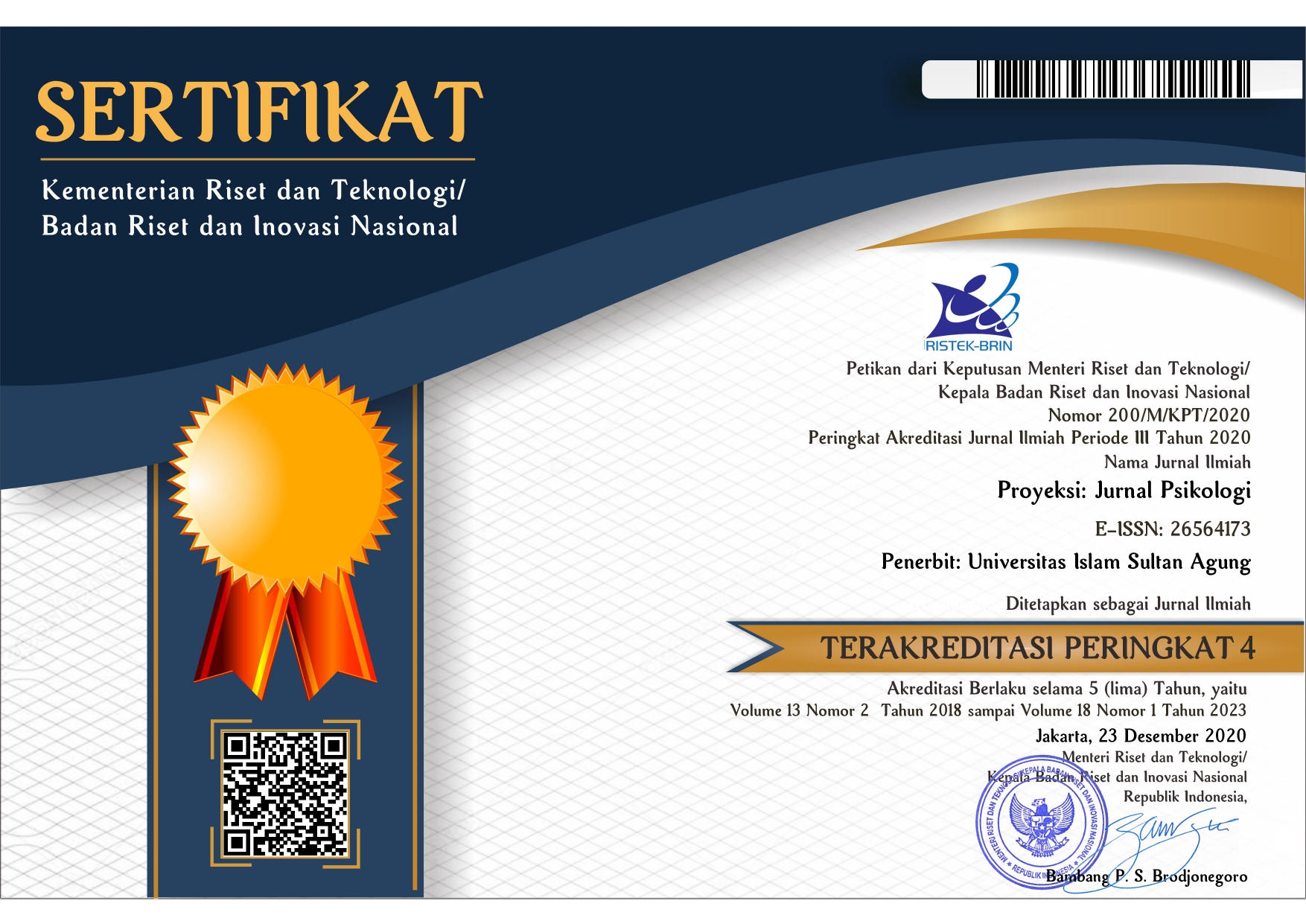EFFECTIVENESS OF EMOTION REGULATION TRAINING ON STRESS, ANXIETY, AND DEPRESSION FOR DOCTORS IN EMERGENCY DEPARTMENT DURING PANDEMIC COVID-19
Abstract
The high risk of disease transmission and mortality in the Hospital Emergency Unit can cause health workers to experience stress, anxiety, and depression. Stress, anxiety, and depression are associated with emotion regulation. Poor emotion regulation, such as poor management of negative emotions, can increase stress to depression. In the emotion regulation training, there are three sessions whose material includes the introduction of emotion regulation, awareness of positive emotions, perception of negative emotions and their forms, acceptance of positive emotions, recognition and reassessment of emotions, and appropriate instruments of self-transformation. Outcomes were measured using a questionnaire on depression, anxiety, stress scale, and cognitive emotion regulation. The variables of depression and emotion regulation have a correlation coefficient of -0.142 with a significant value of 0.69. Based on this score, depression and emotion regulation have a negative and significant relationship. The relationship between the stress variable and emotion regulation has a correlation coefficient of -0.486 with a significant value of 0.154. Based on this score, depression and emotion regulation have negative and significant relations. Based on the different tests, the results of the pre-test and post-test were stress (0.005), depression (0.005), and emotion regulation (0.013). Emotion regulation training can reduce stress and depression for doctors in the Emergency Unit.
Keywords
Full Text:
PDFReferences
Abdi, S., Taban, S., & Ghaemian, A. (2012). Cognitive emotion regulation questionnaire: Validity and reliability of Persian translation of CERQ-36 item. Procedia - Social and Behavioral Sciences, 32, 2–7. https://doi.org/10.1016/j.sbspro.2012.01.001
Behrouian, M., Ramezani, T., Dehghan, M., Sabahi, A., & Ebrahimnejad Zarandi, B. (2020). The Effect of Emotion Regulation Training on Stress, Anxiety, and Depression in Family Caregivers of Patients with Schizophrenia: A Randomized Controlled Trial. Community Mental Health Journal, 56(6), 1095–1102. https://doi.org/10.1007/s10597-020-00574-y
Bosmans, M. W. G., Hofland, H. W., De Jong, A. E., & Van Loey, N. E. (2015). Coping with burns: The role of coping self-efficacy in the recovery from traumatic stress following burn injuries. Journal of Behavioral Medicine, 38(4), 642–651. https://doi.org/10.1007/s10865-015-9638-1
Gross, J. J. (1998). The Emerging Field of Emotion Regulation: An Integrative Review. Review of General Psychology, 2(3), 271–299. https://doi.org/10.1037/1089-2680.2.3.271
Gross, J. J. (2013). Emotion regulation: Taking stock and moving forward. Emotion, 13(3), 359–365. https://doi.org/10.1037/a0032135
Gross, J. J. (2014). Emotion regulation: Conceptual and empirical foundations. In Handbook of emotion regulation, 2nd ed. (pp. 3–20). The Guilford Press.
Hobfoll, S. E. (2001). The Influence of Culture, Community, and the Nestedâ€Self in the Stress Process: Advancing Conservation of Resources Theory. Applied Psychology, 50(3), 337–421. https://doi.org/10.1111/1464-0597.00062
Joormann, J., & Vanderlind, W. M. (2014). Emotion Regulation in Depression: The Role of Biased Cognition and Reduced Cognitive Control. Clinical Psychological Science, 2(4), 402–421. https://doi.org/10.1177/2167702614536163
Kharatzadeh, H., Alavi, M., Mohammadi, A., Visentin, D., & Cleary, M. (2020). Emotional regulation training for intensive and critical care nurses. Nursing & Health Sciences, 22(2), 445–453. https://doi.org/10.1111/nhs.12679
Liang, H., Chen, C., Li, F., Wu, S., Wang, L., Zheng, X., & Zeng, B. (2020). Mediating effects of peace of mind and rumination on the relationship between gratitude and depression among Chinese university students. Current Psychology, 39(4), 1430–1437. https://doi.org/10.1007/s12144-018-9847-1
Loevaas, M. E. S., Sund, A. M., Patras, J., Martinsen, K., Hjemdal, O., Neumer, S.-P., Holen, S., & Reinfjell, T. (2018). Emotion regulation and its relation to symptoms of anxiety and depression in children aged 8–12 years: Does parental gender play a differentiating role? BMC Psychology, 6(1), 42. https://doi.org/10.1186/s40359-018-0255-y
Mauss, I. B., Bunge, S. A., & Gross, J. J. (2007). Automatic Emotion Regulation: Automatic Emotion Regulation. Social and Personality Psychology Compass, 1(1), 146–167. https://doi.org/10.1111/j.1751-9004.2007.00005.x
Moriya, J., & Takahashi, Y. (2013). Depression and interpersonal stress: The mediating role of emotion regulation. Motivation and Emotion, 37(3), 600–608. https://doi.org/10.1007/s11031-012-9323-4
Nesayan, A., Department of Psychology, Faculty of Human Sciences, University of Bojnord, Bojnord, Iran., Hosseini, B., Department of Psychology, Faculty of Human Science, Bojnord Branch, Islamic Azad University, Bojnord, Iran., Asadi Gandomani, R., & Department of Psychology, Faculty of Human Sciences, University of Bojnord, Bojnord, Iran. (2017). The Effectiveness of Emotion Regulation Skills Training on Anxiety and Emotional Regulation Strategies in Adolescent Students. Practice in Clinical Psychology, 5(4), 263–270. https://doi.org/10.29252/nirp.jpcp.5.4.263
Nolen-Hoeksema, S., & Aldao, A. (2011). Gender and age differences in emotion regulation strategies and their relationship to depressive symptoms. Personality and Individual Differences, 51(6), 704–708. https://doi.org/10.1016/j.paid.2011.06.012
Osman, A., Wong, J. L., Bagge, C. L., Freedenthal, S., Gutierrez, P. M., & Lozano, G. (2012). The Depression Anxiety Stress Scales-21 (DASS-21): Further Examination of Dimensions, Scale Reliability, and Correlates: Depression Anxiety Stress. Journal of Clinical Psychology, 68(12), 1322–1338. https://doi.org/10.1002/jclp.21908
Pisani, A. R., Wyman, P. A., Petrova, M., Schmeelk-Cone, K., Goldston, D. B., Xia, Y., & Gould, M. S. (2013). Emotion Regulation Difficulties, Youth–Adult Relationships, and Suicide Attempts Among High School Students in Underserved Communities. Journal of Youth and Adolescence, 42(6), 807–820. https://doi.org/10.1007/s10964-012-9884-2
Restubog, S. L. D., Ocampo, A. C. G., & Wang, L. (2020). Taking control amidst the chaos: Emotion regulation during the COVID-19 pandemic. Journal of Vocational Behavior, 119, 103440. https://doi.org/10.1016/j.jvb.2020.103440
Tamir, M. (2009). What Do People Want to Feel and Why?: Pleasure and Utility in Emotion Regulation. Current Directions in Psychological Science, 18(2), 101–105. https://doi.org/10.1111/j.1467-8721.2009.01617.x
Tengilimoğlu, D., Zekioğlu, A., Tosun, N., Işık, O., & Tengilimoğlu, O. (2021). Impacts of COVID-19 pandemic period on depression, anxiety and stress levels of the healthcare employees in Turkey. Legal Medicine, 48, 101811. https://doi.org/10.1016/j.legalmed.2020.101811
Tsai, Y.-H., Joe, S.-W., Chen, M.-L., Lin, C.-P., Ma, H.-C., & Du, J.-W. (2016). Assessing team performance: Moderating roles of transactive memory, hypercompetition, and emotional regulation. Human Performance, 29(2), 89–105. https://doi.org/10.1080/08959285.2016.1154059
Xu, H. (Grace), Johnston, A. N. B., Greenslade, J. H., Wallis, M., Elder, E., Abraham, L., Thom, O., Carlström, E., & Crilly, J. (2019). Stressors and coping strategies of emergency department nurses and doctors: A cross-sectional study. Australasian Emergency Care, 22(3), 180–186. https://doi.org/10.1016/j.auec.2018.10.005
DOI: http://dx.doi.org/10.30659/jp.17.1.78-88
Refbacks
- There are currently no refbacks.

Proyeksi by http://jurnal.unissula.ac.id/index.php/proyeksi/ is licensed under a Creative Commons Attribution-ShareAlike 4.0 International License.

